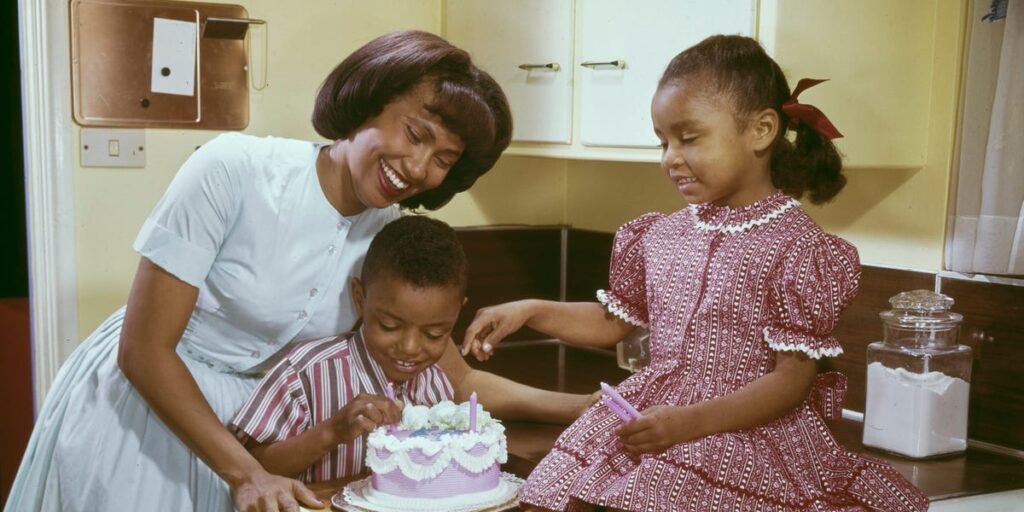X
Copy link
Impact Link
Save
Saved
Read in app
subscribers. Become an Insider
and start reading now.
Have an account? .
- Motherhood in the US has changed over the past century.
- From baby formula to women entering the workforce, mothers have faced a range of societal changes.
- Debates over best practices for raising a child have been ongoing for decades.
Mother’s Day might be over, but most mothers would agree the celebration shouldn’t end there.
Motherhood can look very different for every mother, with factors like culture, finances, and family structures creating a unique experience for every mom.
Over the course of history, motherhood has drastically changed, from societal norms to parenting trends.
Practices like wet nurses and postpartum confinement might have gone mostly out of fashion in the US, but the face of motherhood didn’t change overnight.
As we celebrate moms beyond Mother’s Day, here are 15 vintage photos that show how motherhood has evolved in the past century, from the invention of baby formula to the rise of mommy bloggers.
Motherhood looked very different for women based on their income level in the 1800s.
While women in the higher classes often relied on dedicated midwives and wet nurses to help deliver and raise their children, low-income women faced the difficult realities that surrounded having children, including high infant mortality rates.
For the low-income women working as wet nurses — that is, a woman employed to breastfeed another woman’s child — for the higher classes, providing their labor often meant leaving their own children behind, as they weren’t allowed to bring them into the homes of the families they worked for.
Baby formula began entering households in the 1890s.
Early milk mixtures were available as far back as 1865, however some of these early iterations — which used cow’s milk and wheat flour — failed to provide children with all the nutrients they needed, JSTOR Daily reported.
The first commercially available baby formulas were available in the late 1800s, with baby formula entering households in the 1890s.
With the increased industrialization and boom of factory work in the 1880s and 1890s, families had to get better as managing their time, historian Jacqueline H. Wolf told Time in 2018. As a result, “infant care manuals” that outlined feeding schedules were published to help parents adapt children to their working schedules, Wolf said.
However, nursing less meant that women began facing challenges in producing the amount of breastmilk their children required, increasing the demand for additional infant nutrition. With growing urban centers lacking the availability of fresh milk that rural populations had due to the presence of dairy farms, powdered baby formula helped mothers provide their children with the nutrition they needed when breastmilk wasn’t available.
For those who could afford it, wet nurses remained popular well into the 1910s.
Wet nursing remained a popular option among well-off women into the 1900s.
In 1913, one doctor asked colleagues throughout the US if they’d assisted any families in hiring a wet nurse, and out of 80 who replied, 72 said they had, a “Journal of Social History” paper reported, per JSTOR Daily.
World War I saw the beginning of women joining the workforce in significant numbers.
Although more women joined the workforce during the late 19th century, mostly out of necessity, World War I saw the first major historical uptick of women in the workforce, with the trend continuing throughout the century. By 1920, women made up 20% of the workforce, according to US Department of Labor data.
Women leaving the house to work highlighted the need for help to facilitate balancing a workweek and childcare, prompting technological advances in the family and household domain.
The invention of the washing machine signaled how new technology could assist mothers in the home.
As women continued to join the workforce, there was a greater need for household appliances that prioritized efficiency. Throughout the century, technological advancements helped alleviate some of the burden of household labor.
Although early hand-powered versions existed and were widely used by women, the modern electric washing machine began being mass-produced in 1906, and by 1910, it was already selling over 40,000 appliances a year, according to the University of Texas.
The 1910s also saw an increased focus on scientific research for childcare.
By the 1910s, advancements in science and medicine brought a new focus on raising children. In 1914, the US Department of Labor released a pamphlet outlining the best practices for infant care, from properly preparing a nursery to developing a feeding schedule.
This time also saw the rise in popularity of “scientific” parenting advice from the emerging field of psychology and pedagogy, with figures like psychologist G. Stanley Hall giving advice to parents on how to best interact with their children.
In a 1911 print of “A Handbook of Obstetric Nursing for Nurses, Students and Mothers,” new mothers were advised to avoid “spoiling” their children into “little tyrants” by holding them for too long.
Parenting styles during this time underwent a shift from the nurturing, motherly approach of the 1900s to a more authoritarian parenting structure that emphasized discipline in hopes of creating better-behaved children.
Hospital births became the norm by 1935 in efforts to reduce infant mortality.
In 1900, nearly all births in the US occurred outside hospitals, per the National Research Council.
While at the beginning of the century nearly half of the babies born in the United States were delivered by midwives, those numbers fell to about 15% by 1935, Margaret Marsh, a history professor at Rutgers University, told NPR’s WHYY.
At the same time, hospital deliveries became more common as women sought out the best medical resources they could attain, and by 1935, over half of births took place in a hospital, according to a 2008 study published in the Explorations in Economic History journal.
Despite more mothers giving birth in hospitals, at first maternal mortality did not decrease, only dropping in the 1930s, the 2008 paper reported — medical intervention during birth might have even increased fatalities at a time when the science of childbirth was still beginning to be understood.
State efforts limited midwifery and pushed for hospital births during this time, and midwifery didn’t become an organized field until the 1920s, as reported by the Oregon Health and Science University.
During World War II, the US government supplied universal childcare.
The US government subsidized universal childcare through facilities that charged parents 50 to 75 cents per day per child, which would be from $9.81 to $14.71 in today’s money, as reported by History.com.
The initiative helped women join the workforce during the war when labor was most critical.
Despite the help it provided mothers, the program ended in 1946 after the war ended.
Throughout the 1950s, baby formula was advertised as the healthier option for babies.
By the 1950s, baby formulas were heavily popularized through advertisement campaigns and doctors’ offices, which provided new mothers with samples.
During this time, some doctors began recommending that mothers use formula over breastmilk due to concerns with the quality of the breastmilk infants were getting, such as when the mothers were too stressed or tired, Yahoo Life reported. As women began entering the workforce in higher numbers, these concerns, along with the perceived flexibility of bottle-feeding, meant that a growing number of mothers didn’t breastfeed their infants.
By 1971, the breastfeeding rate in the US had reached an all-time low, with 24% of new mothers breastfeeding their newborns before being discharged from hospital, as reported in a 2003 paper by Professor Wolf.
By the 1960s, more women had entered the workforce, leading to the rise of two-career families and the need for childcare options.
During the 1950s and 1960s, more women worked outside the home, with over 40% of women participating in the workforce by 1966, according to the US Bureau of Labor Statistics.
With the changing labor environment, new challenges to motherhood — and balancing home and work lives — also emerged, from feeding schedules with infants to a growing necessity for childcare options.
American family dynamics began to shift from having one parent (usually the mother) stay at home to having two working parents, as reported in a 2021 paper.
The US government expanded childcare funding throughout the decade in response to the growing need for childcare options. In 1965, the Office of Economic Opportunity launched Project Head Start, a summer program that provided low-income families with preschool instruction and support for children aged 3 to 5.
(Since then, the program has expanded beyond its initial time and age limitation, and in 2023 over 700,000 children enrolled in preschool programs through Head Start and Early Head Start, according to the most recent data from the US Department of Health and Human Services.)
Breastfeeding rose in popularity in the 1970s, fueled by a feminist wave and controversies over baby formula marketing.
A combination of more information about the effects of formula-feeding infants and a rising feminist movement that aimed to reclaim motherhood powered a resurgence of breastfeeding in the 1970s.
This rise also coincided with a boycott campaign against baby formula producer Nestlé, which the campaign accused of predatory marketing practices in countries in Latin America and Africa.
The company sued the publishers of the pamphlet promoting the boycott in 1974, with the publishers were found guilty of libel against the company, as reported by The New York Times.
Despite winning the case in the Swiss courts, the company was instructed to “reconsider its advertising policies if it wants to avoid being accused of immoral conduct,” said Judge Jürg Sollberger, who presided over the case.
The controversy over baby formula marketing led the World Health Organization to officially release guidelines for formula marketing in 1981.
By 2001, the WHO had released a report lauding the nutritional value of breastmilk for infants and recommending that babies breastfeed for at least six months after birth.
As women stayed in the workforce, the demand for day-care services increased.
During the 1970s and 1980s, increased female participation in the workforce, which remained over 50% after 1978, highlighted the need for childcare options for parents of infants.
The rates of enrollment in childcare have steadily gone up since they began being measured in 1980, and by 1995, over half of the children between ages 3 and 5 in the US attended day care, according to the National Center for Education Statistics.
Some working mothers began to receive paid maternity leave in the mid-1980s.
By 1984, discussions about paid maternity leave had begun entering the legislative government, but it took until 1993 for Congress to pass the Family and Medical Leave Act, which provided some women and men with up to 12 weeks of unpaid leave, as reported by the Organization of American Historians.
Still, the measure limited the job protections to certain categories of workers meeting a set of guidelines, leaving about 40% of workers uncovered.
Since then, 13 states and the District of Columbia have enacted paid family leave laws, as reported by the Bipartisan Policy Center, but no national protections exist for paid leave.
Despite concerns about working mothers, studies showed that children were content.
Throughout the 1990s, debates between working and stay-at-home moms began dividing social spheres. These “mommy wars,” as they were called in a 1995 opinion piece in the Washington Post, divided women as they navigated changes in the workforce and at home.
Working mothers could be shamed for dividing their time and dedication between their work and their families. But in 2000, Ellen Galinsky’s “Ask the Children” — for which the author talked with over 1,000 children of working parents — found kids did not wish for their parents to spend more time with them, but for their parents to be less stressed and tired, as Galinsky said in an interview with PBS.
At the same time, a 2004 paper noted pediatric dentists had reported a change in parenting techniques, with younger parents refraining from disciplining children in the ways that previous generations had and were more overprotective of their children.
With the digital age, mothers began connecting online through mommy blogs.
Along with many technological innovations aimed at helping parents, from smart monitors to iPads, the digital era saw the rise of online communities focused on helping moms connect with one another and bond over shared experiences.
The early internet days gave women the tools to engage with one another in discussions about the raw and difficult realities of motherhood through “mommy blogs,” as reported by The New York Times.
Conversations on these blogs helped moms open up about topics that were previously seen as taboo, like postpartum depression and challenges with breastfeeding. Increased attention on these topics, along with the growing online network of mothers supporting one another, led to media coverage and research that has slowly brought motherhood, even the ugly parts, to the limelight of American life.
Read the full article here

















